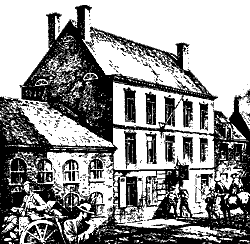The Princess Mary Tin
Christmas 1914
Princess Mary was the teenage daughter of King George V and Queen Mary. Very early in the First World War, she created a fund, known as the ‘Sailors and Soldiers Christmas Fund’, with the purpose of giving everyone serving overseas in the forces on Christmas Day 1914, a ‘gift from the nation’. It was decided to use the fund to provide each person with a specially designed and manufactured brass ‘tin’ box containing various goodies. The brass ‘tin’ box has a double-skinned, hinged lid and is about 1 ¼ ins. deep, 3 ¼ ins. wide, and 5 ins. long. The centre of the lid is beautifully embossed with a profile of Princess Mary surrounded by a laurel wreath, the letter 'M' being impressed on either side of the image. The top panel depicts a sword and scabbard either side of the wording ‘Imperium Britannicum’. The bottom panel shows the bows of a battleship with a central nameplate which reads ‘CHRISTMAS 1914’. The two side panels and the four corners of the lid contain the names of the Allies: Japan, Russia, Montenegro, Servia, France and Belgium.
All the brass 'tin' boxes contained a Christmas card and picture of Princess Mary, but any that were sent out after Christmas 1914 contained a card wishing them a victorious New Year.
The contents of the box generally followed the pattern below:
Officers and men on active service (afloat or at the front):
A combination of – pipe, 1 oz tobacco, lighter, 20 cigarettes.
Non-smokers and boys:
Packet of sweets and bullet pencil
Nurses:
Chocolate
Talbot House - Toc H
Talbot House, better known to the British soldiers as ‘Toc H’, is also featured in my book ‘A Song in the Night’. It was a large house owned by a brewer, and was situated on a street called Rue de l’Hôpital (now 43 Gasthuisstrat) in Poperinghe, Belgium. 'Pops' as it was known, was set back a few miles from the trenches at Ypres and was a very busy transfer station for troops going to and from the battlefields of Flanders.
During the early summer of 1915, the garden at the back of the house was badly damaged and covered in shrapnel, following which the owner evacuated his family and all his belongings to a safer place. He rented the empty house to the British Army with a condition that they made the property weatherproof.
The Reverend Philip Clayton, known as 'Tubby' Clayton, was an Army Chaplain at the time and was sent by his senior chaplain, Padre Neville Talbot, to set up a rest house for the troops. The evacuated building on the Rue de l’Hôpital proved to be just the place Tubby was looking for. The house had to be refurnished, and soldiers soon found all sorts of furniture from the locality. Various items including books for the library came from England. The house was opened on 11th December 1915 as a place where soldiers of all ranks could meet and chill out. Soldiers had to leave a cap badge as a pledge for borrowing a book from the library. A notice hung over the door saying, 'All rank abandon, ye who enter here.'
The loft of the house had been used for drying hops and was converted into a chapel. It became known as 'the Upper Room' . There was an organ for musical activities including hymn singing and concert performances. The 'Upper Room' became a place of peace for many soldiers taking time out from the trenches. It was also a place where some soldiers were confirmed as Christians and received their first, and sometimes their very last, communion.
The house soon became inadequate for accommodating all the soldiers meeting there. In 1916 the first floor of the neighbouring hop store was taken over and used for church services for larger groups. This room was known as the Church Hall and later, the Concert Hall. It became a multi-purpose area housing such activities as lectures, concerts, debates and lessons.
How did it get its name?
At first it was intended to name the house 'Church House', but army staff considered that this sounded too religious and off-putting to some soldiers.
It was then decided to call it 'Talbot House' in memory of Lieutenant Gilbert W L Talbot who was the brother of Padre Neville Talbot (both sons of Lord Bishop Talbot of Winchester). Gilbert had been killed at Hooge in the Ypres Salient on 30th July 1915. He was buried at Sanctuary Wood Military Cemetery. The original cross which marked Gilbert’s grave is still preserved in the Upper Room.
Talbot House became affectionately known by the Tommies as Toc H, TOC being the army signaller's code for 'T' and H being 'H'.
A vehicle convoy of the Army Service Corps outside the Castle & Ball Hotel, Marlborough in Wiltshire

Drivers of the Army Service Corps - Mechanical Transport
SECTION 881 COY

Drivers of the Army Service Corps - Mechanical Transport
SECTION 881 COY

A typical Silk postcard sent to loved ones during World War I

Soldiers of the North Lancs Regiment cheering
when ordered to the trenches

Soldiers kneeling to pray at a church service before going into battle

Copyright © Julie Maria Peace 2012
A Princess Mary tin is featured in my book,
‘A Song in the Night’.
Above is an example of a Princess Mary tin which my lovely husband bought me as a surprise gift. It's rather dented and well-worn but it polishes up a treat. I love it!


This is my husband's grandfather
Private George Thorpe - Driver
Army Service Corps Regiment No. T4/041329

George Thorpe's brother and sisters
during the War

POSTCARDS
Typical religious postcards sent to loved ones during World War I

